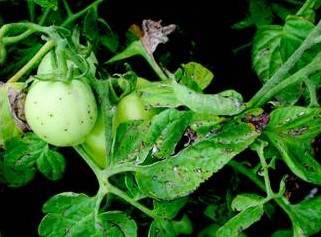
Features
Production
Research
Researchers unravel tomato pathogen’s tricks
November 16, 2011 By Virginia Tech
 November 14, 2011 – The
November 14, 2011 – The
genome of several Pseudomonas syrinage pv. tomato isolates have been sequenced
in order to track the bacterial pathogen’s ability to overcome plant defenses
and to develop methods to prevent further spread.
November 14, 2011 – The
genome of several Pseudomonas syrinage pv. tomato isolates have been sequenced
in order to track the bacterial pathogen’s ability to overcome plant defenses
and to develop methods to prevent further spread.
For decades, scientists
and farmers have attempted to understand how a bacterial pathogen continues to
damage tomatoes despite numerous agricultural attempts to control its spread.
 |
|
Pseudomonas syringae pv.
tomato is the causative agent of bacterial speck disease of tomato (Solanum
lycopersicum), a disease that occurs worldwide and causes severe reduction in
fruit yield and quality, particularly during cold and wet springs.
In the spring of 2010, for
example, an outbreak in Florida and California devastated the harvest in those
areas.
“There is not much that
can be done from a farming standpoint,” said Boris Vinatzer, associate
professor of plant pathology, physiology and weed science, and an affiliated
faculty member with the Fralin Life Science Institute at
Virginia Tech. “First, farmers try to use seed that is free of the pathogen to
prevent disease outbreaks. Then, there are some disease-resistant tomato
cultivars, but the pathogen has overcome this resistance by losing the gene
that allowed these resistant plants to recognize it and defend themselves. For
the rest, there are pesticides but the pathogen has become resistant against
them.”
So how exactly has the
pathogen evolved to consistently evade eradication efforts? This is where
science steps in, and a copy of the bacterial pathogen's game plan is crucial.
Thanks to the
collaborative work of Vinatzer, the Virginia Bioinformatics Institute computer scientist Joao Setubal, assistant professor of
statistics Scotland Leman, and their students, the genome of several
Pseudomonas syrinage pv. tomato isolates have been sequenced in order to track
the bacterial pathogen's ability to overcome plant defenses and to develop
methods to prevent further spread.
Their findings were
recently published in an issue of PLoS Pathogens, a peer reviewed open-access
journal published by the Public Library of Science.
The research team has
studied the pathogen for nearly five years. In 2007, with resources from the
Virginia Bioinformatics Institute and the Fralin Life Science Institute,
Vinatzer sequenced the genome of Pseudomonas syringae pv. tomato using a Roche
GS-FLX ™ sequencer at the Virginia Bioinformatics Institute.
In 2008, Vinatzer received
a $1 million, five-year Faculty Early Career Development (CAREER) Award from
the National Science Foundation to continue investigation of the pathogen.
Shortly thereafter, he brought Setubal, a former Virginia Tech faculty member
who recently went to work for the University of Sao Paulo in Brazil, and Leman,
onto the project to handle the bioinformatics and statistical aspects of the
research, respectively.
First, the scientists
needed to map changes in the bacterial pathogen over large spans of time. They
compared DNA sequences of bacteria isolated in multiple years, dating back to
1960 and stored since then in international culture collections. Setubal, along
with Nalvo Almeida, an associate professor at the Federal University of Mato
Grosso do Sul, provided automated genome annotation and helped Vinatzer with
identification and analysis of mutations that distinguished the sequenced
genomes.
“One of the questions we
asked was, did the bacteria isolated in 2000 directly evolve from the bacteria
isolated in 1975, or did they evolve independently from an ancestor that lived
further back in time, maybe 100 to 200 years ago?” said Vinatzer.
To answer this question,
Leman, Vinatzer, and Rongman Cai of Lixian, China, a PhD student in plant
pathology, physiology, and weed science at Virginia Tech, used statistical
methods to correlate the differences in the DNA sequences between the isolated
bacteria with the years in which they were isolated to determine if the
bacteria progressively became more different from the first bacteria isolated
in 1960.
The research team found
that the pathogen likely evolved on a relatively recent time scale and
continues to adapt to the tomato by minimizing its recognition by the tomato
immune system. This suggests that new pathogen variants with increased
virulence are spreading around the globe unobserved, presenting a potential
threat to biosecurity. Ultimately, it calls for more precise methods of
pathogen identification to replace outdated taxonomic descriptions that were
established at a time when it was impossible to classify bacteria precisely
because the necessary molecular techniques had not been developed yet.
This particular pathogen
is important to study because “it has been used as a model pathogen by many
labs around the world and is economically significant because it reduced tomato
quality and yield,” said Vinatzer. He is extending the research project to investigate
where the pathogen originally evolved, how it is spreading around the globe,
and what can be done to interfere with its spread, including how the tomato
might be engineered to be more resistant to the pathogen.
Print this page